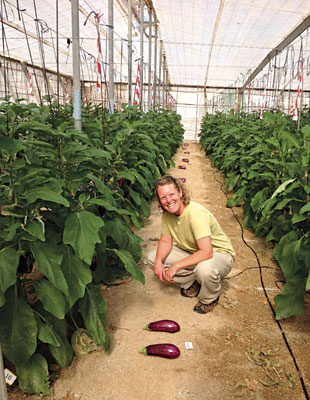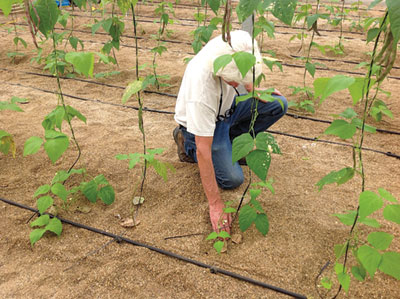 |
| Eric Sideman alongside one of the high tunnels in Almería, Spain, where the density of reflective tunnels has lowered temperatures in the area. Becky Sideman photo |
By Eric Sideman, Ph.D.
Those of you who know me know that I never look forward to leaving my farm. I have to be talked into traveling – and last fall my wife, Becky (the vegetable and small fruit specialist at the University of New Hampshire), did just that. While she was on sabbatical, we went to Almería, Spain.
A sabbatical, despite the fact that some people think it is a vacation, is meant to provide an opportunity to drop the humdrum daily chores and see something entirely different; an opportunity to broaden the base on which your knowledge rests. It may or may not offer knowledge of specific facts that will help with your daily job. It is more about seeing new things or new ways of doing things that you don’t have time to see or try while doing your job, in order to continue to expand the foundation on which your knowledge rests. I was promised a sabbatical of some sort by Dick Wells, president of MOFGA when I was hired in 1986. I guess I finally got it!
Almería is in the southeast of Spain between the Sierra Nevada Mountains and the Mediterranean Sea. It did not sound like a bad place to visit, and Becky wanted to go there to see a unique system of growing warm weather crops in the winter in tunnels. She only had to show me a photograph taken from space (https://geographyfieldwork.com/AlmeriaClimateChange.htm) and I was ready to go.
Yes, you can see Almería from space, because the multitude of tunnels there creates a sea of white. In fact, the sea of white is so large that it has changed the regional climate. As the average temperature in most of the rest of Spain has increased during the past few decades, it has decreased in this region.
 |
| Becky Sideman in one of the tunnels where eggplants are growing. The farmers in this area grow tomatoes, peppers, eggplants, green beans, cucumbers, watermelons and more to supply northern Europe during the cold months. Eric Sideman photo |
Remember the term “albedo” – the fraction of solar energy reflected from the earth back into space? Ice, especially with snow on top of it, has a high albedo and plays a big role in keeping the earth cool (until it melts because of climate change). Since 1983, the albedo in the Almería has increased because all the greenhouses reflect 9 percent more energy into the atmosphere than before the tunnels were erected. That magnitude of change would take a lot of plastic! “I gotta see that,” I said, and off we went.
Almería is just as cool from the ground as from space. Essentially it is a city of tunnels with narrow streets between them (photo 1) and with warm season vegetables growing inside them. The farmers in this southeastern part of Spain grow mostly tomatoes but also peppers, eggplants, green beans, cucumbers, watermelons and more to supply northern Europe during the cold months. It is warm here in winter, hot in summer. Crops grow in these tunnels from September through May; summer is too hot. Frost may occur once in a while in the middle of winter, but for the most part the Sierra Nevada Mountains keep the cold air north. Also, nearly every day is sunny here. It is a desert.
Over the past 1,000 years or more, people from all over the world – Romans, Moors, etc. – have occupied this region, controlling the land and using the natural resources for their gain. In the late 1400s, Spain was strong enough to kick everyone out, and from then until the 1950s or so, only some subsistence farmers lived in the Almería region. Remember, it is essentially desert.
In the mid-1950s, change began with a resettlement program. The government sold land to settlers, developed irrigation-accessing aquifers and provided support for a new type of farming. The unique system that was developed, called the “Enarenado” or the sand culture technique, is a testament to farmers’ ability to solve problems. For years farmers grew crops on their 5-or-so-acre piece of ground. In the late ‘50s they began to cover their plots with simple tunnels, and this practice exploded in the ‘70s and ‘80s. There is no snow here, so the tunnels do not need to be significant structures. They are made from posts and a system of wires that support 4- to 8-mil plastic. No heat is added. Ventilation is passive, with the sides of the tunnels dropped down during the day and pulled up at night.
The sand culture technique (photo 2) was developed because the soil in the region is poor, and, more important, water is a very valuable commodity that must be conserved. First, farmers scrape away most of the native soil, then they compact what remains. Then they put 8 to 12 inches of loam on top of the compacted layer, followed by about 1/2 to 2-1/2 inches of manure or compost, which is topped with about 3 to 5 inches of coarse sand. No water leaches from the system because of the compacted layer, and little water evaporates because of the sand. Drip irrigation is used, and fertility comes from the added manure and soil as well as from fertigation (soluble fertilizers) through the drip system. The manure and sand are replaced every three to five years to deal with potential salt buildup and other issues.
More than 100,000 acres are under cover, nearly all family-run farms of about 5 or 6 acres with just a few laborers each. Still, these are not like New England family farms. You never see a house and barn. This is a city of plastic with each covered plot butted up against the neighbor’s plot. Farmers and laborers live away from the farm.
 |
| Almería farmers use a cultivation system called the “Enarenado” or sand culture technique, which conserves water and nutrients. Becky Sideman photo |
Support for farming is strong because so much of it occurs in such a concentrated area. The plastic is made and recycled right in Almería. Seed companies are in Almería. Because farmers use every bit of their tunnel for production, they work with nurseries – neighborhood cooperatives – to raise their seedlings. Marketing occurs right there, too, in auction houses and run as a “Dutch” auction: The auctioneer begins with a high asking price, which is lowered until some participant (farmer) is willing to accept the price the auctioneer gets from a buyer. This system is much more likely to result in a profit for the farmer than is a typical auction.
If you buy a tomato in Paris in the winter, it likely came from southern Spain, from “Almería’s economic miracle.” In a few decades one of the poorest regions in Spain has turned into one of the richest. Profitable family farms – a dream all of us have.
How long can it last? Well, there is an ugly side to this, and much work is being done to keep it from getting worse. This type of agriculture depends on water from away – from aquifers fed from rain and snow in the Sierra Nevada Mountains. At first too much water was being used. Now great efforts have been made to tighten water conservation. In fact, desalination plants that have been built along the coast have not been brought on-line yet because conservation has tempered the demand for water. Who knows what the future will bring. And now that the word is out, tourists are a growing issue as they compete for water, sand and space. I hope we were not part of the problem!
Eric is MOFGA’s organic crop specialist. You can reach him at 568-4142 or [email protected].
